Nursing Staffing Regulation: Policy, Cost, and Impact Analysis Report
VerifiedAdded on 2020/05/16
|5
|1152
|199
Report
AI Summary
This report examines nursing staffing regulations in the US, focusing on the implementation of nurse-to-patient ratios and their impact on healthcare. It discusses the financial and budgetary efforts associated with these policies, including the costs of recruiting additional nurses and the proposed cost-control programs such as incentives, penalties, and federal support through the Nurse Reinvestment Act and the American Recovery and Reinvestment Act. The report also explores alternative billing methods like the nurse intensity billing model and analyzes the effects of these regulations on patient outcomes, emphasizing the potential for reducing medical errors. The study uses California as a case study and highlights the challenges faced by hospitals in meeting these ratios and suggests strategies to alleviate the financial burden. This report provides a detailed overview of the current state of nursing staffing regulations and their implications for the healthcare system.
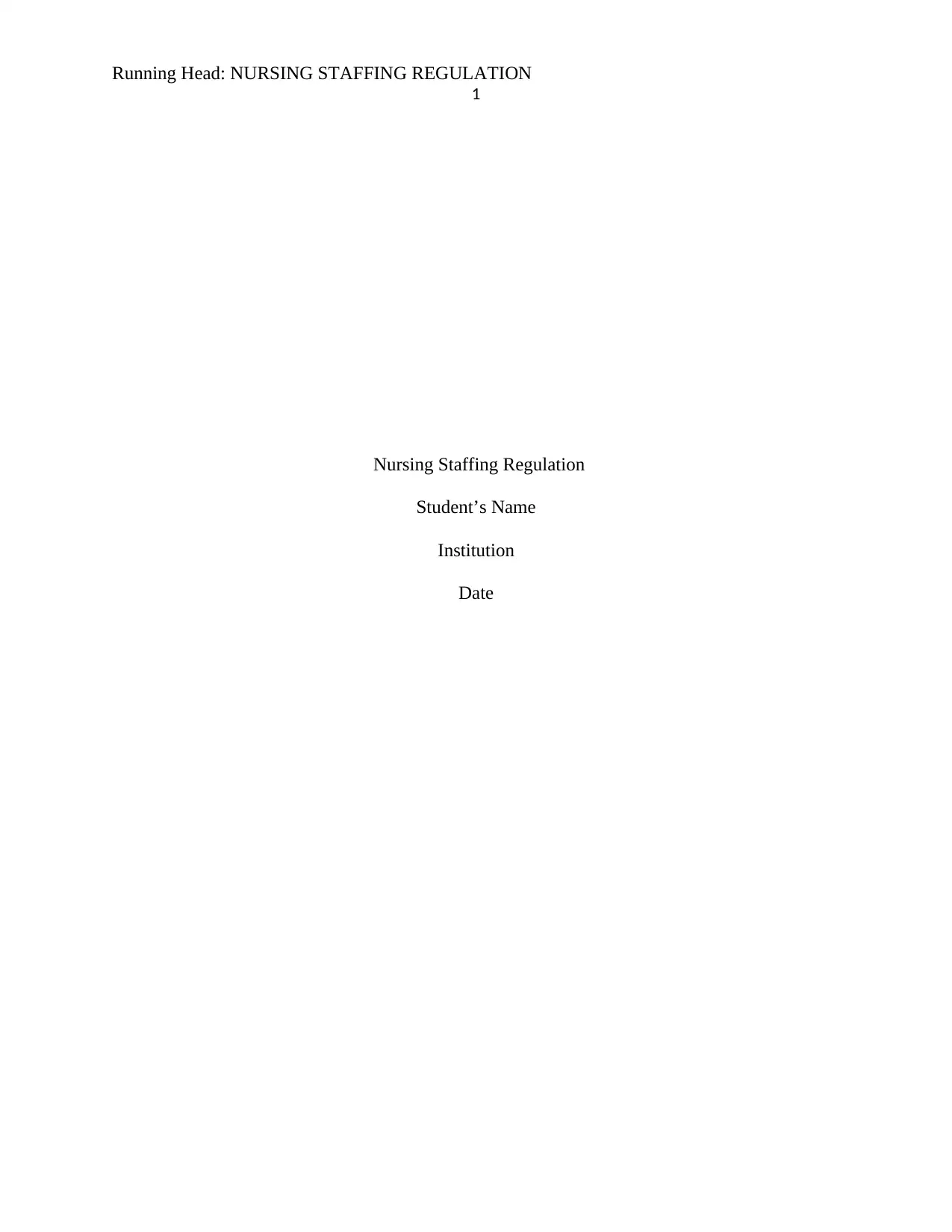
Running Head: NURSING STAFFING REGULATION
1
Nursing Staffing Regulation
Student’s Name
Institution
Date
1
Nursing Staffing Regulation
Student’s Name
Institution
Date
Paraphrase This Document
Need a fresh take? Get an instant paraphrase of this document with our AI Paraphraser
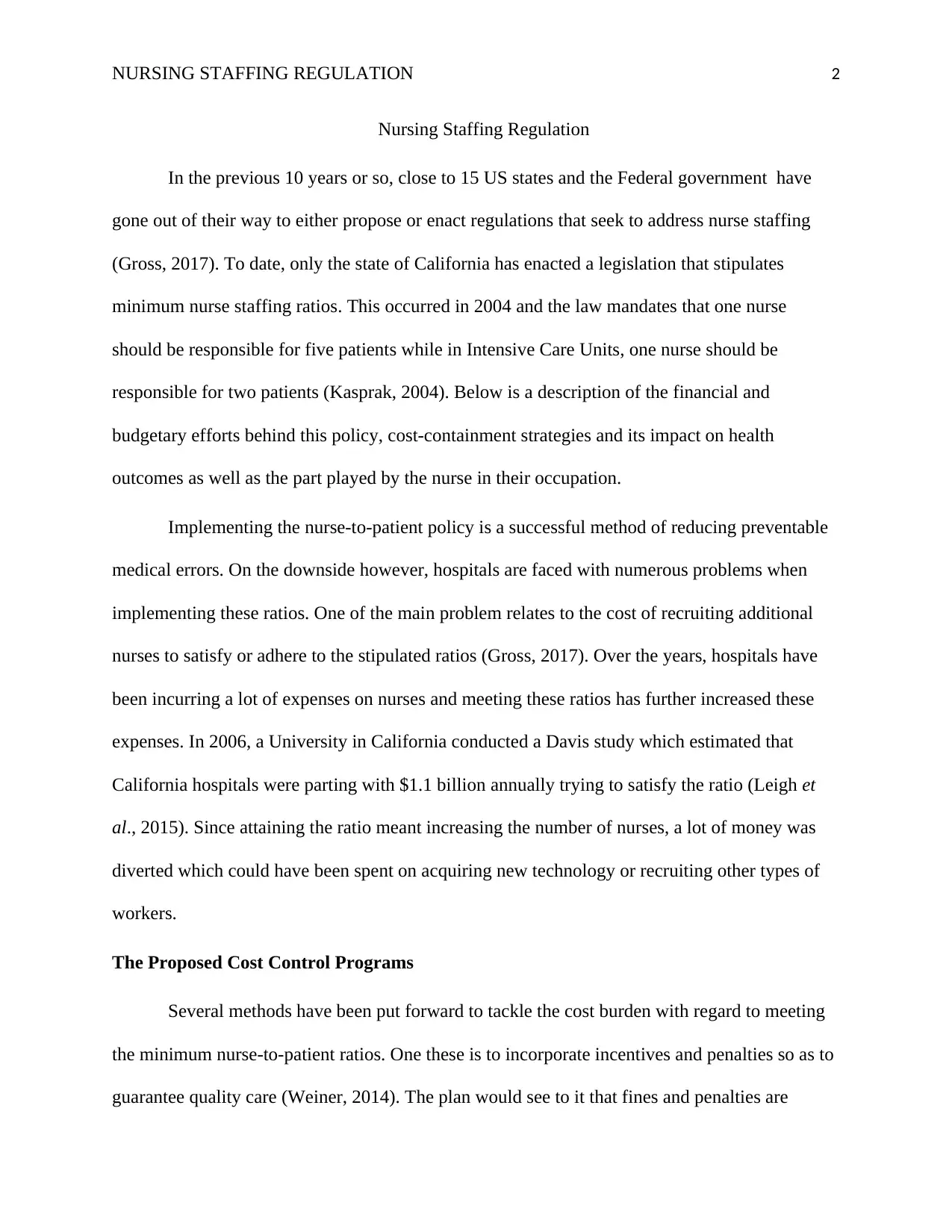
NURSING STAFFING REGULATION 2
Nursing Staffing Regulation
In the previous 10 years or so, close to 15 US states and the Federal government have
gone out of their way to either propose or enact regulations that seek to address nurse staffing
(Gross, 2017). To date, only the state of California has enacted a legislation that stipulates
minimum nurse staffing ratios. This occurred in 2004 and the law mandates that one nurse
should be responsible for five patients while in Intensive Care Units, one nurse should be
responsible for two patients (Kasprak, 2004). Below is a description of the financial and
budgetary efforts behind this policy, cost-containment strategies and its impact on health
outcomes as well as the part played by the nurse in their occupation.
Implementing the nurse-to-patient policy is a successful method of reducing preventable
medical errors. On the downside however, hospitals are faced with numerous problems when
implementing these ratios. One of the main problem relates to the cost of recruiting additional
nurses to satisfy or adhere to the stipulated ratios (Gross, 2017). Over the years, hospitals have
been incurring a lot of expenses on nurses and meeting these ratios has further increased these
expenses. In 2006, a University in California conducted a Davis study which estimated that
California hospitals were parting with $1.1 billion annually trying to satisfy the ratio (Leigh et
al., 2015). Since attaining the ratio meant increasing the number of nurses, a lot of money was
diverted which could have been spent on acquiring new technology or recruiting other types of
workers.
The Proposed Cost Control Programs
Several methods have been put forward to tackle the cost burden with regard to meeting
the minimum nurse-to-patient ratios. One these is to incorporate incentives and penalties so as to
guarantee quality care (Weiner, 2014). The plan would see to it that fines and penalties are
Nursing Staffing Regulation
In the previous 10 years or so, close to 15 US states and the Federal government have
gone out of their way to either propose or enact regulations that seek to address nurse staffing
(Gross, 2017). To date, only the state of California has enacted a legislation that stipulates
minimum nurse staffing ratios. This occurred in 2004 and the law mandates that one nurse
should be responsible for five patients while in Intensive Care Units, one nurse should be
responsible for two patients (Kasprak, 2004). Below is a description of the financial and
budgetary efforts behind this policy, cost-containment strategies and its impact on health
outcomes as well as the part played by the nurse in their occupation.
Implementing the nurse-to-patient policy is a successful method of reducing preventable
medical errors. On the downside however, hospitals are faced with numerous problems when
implementing these ratios. One of the main problem relates to the cost of recruiting additional
nurses to satisfy or adhere to the stipulated ratios (Gross, 2017). Over the years, hospitals have
been incurring a lot of expenses on nurses and meeting these ratios has further increased these
expenses. In 2006, a University in California conducted a Davis study which estimated that
California hospitals were parting with $1.1 billion annually trying to satisfy the ratio (Leigh et
al., 2015). Since attaining the ratio meant increasing the number of nurses, a lot of money was
diverted which could have been spent on acquiring new technology or recruiting other types of
workers.
The Proposed Cost Control Programs
Several methods have been put forward to tackle the cost burden with regard to meeting
the minimum nurse-to-patient ratios. One these is to incorporate incentives and penalties so as to
guarantee quality care (Weiner, 2014). The plan would see to it that fines and penalties are
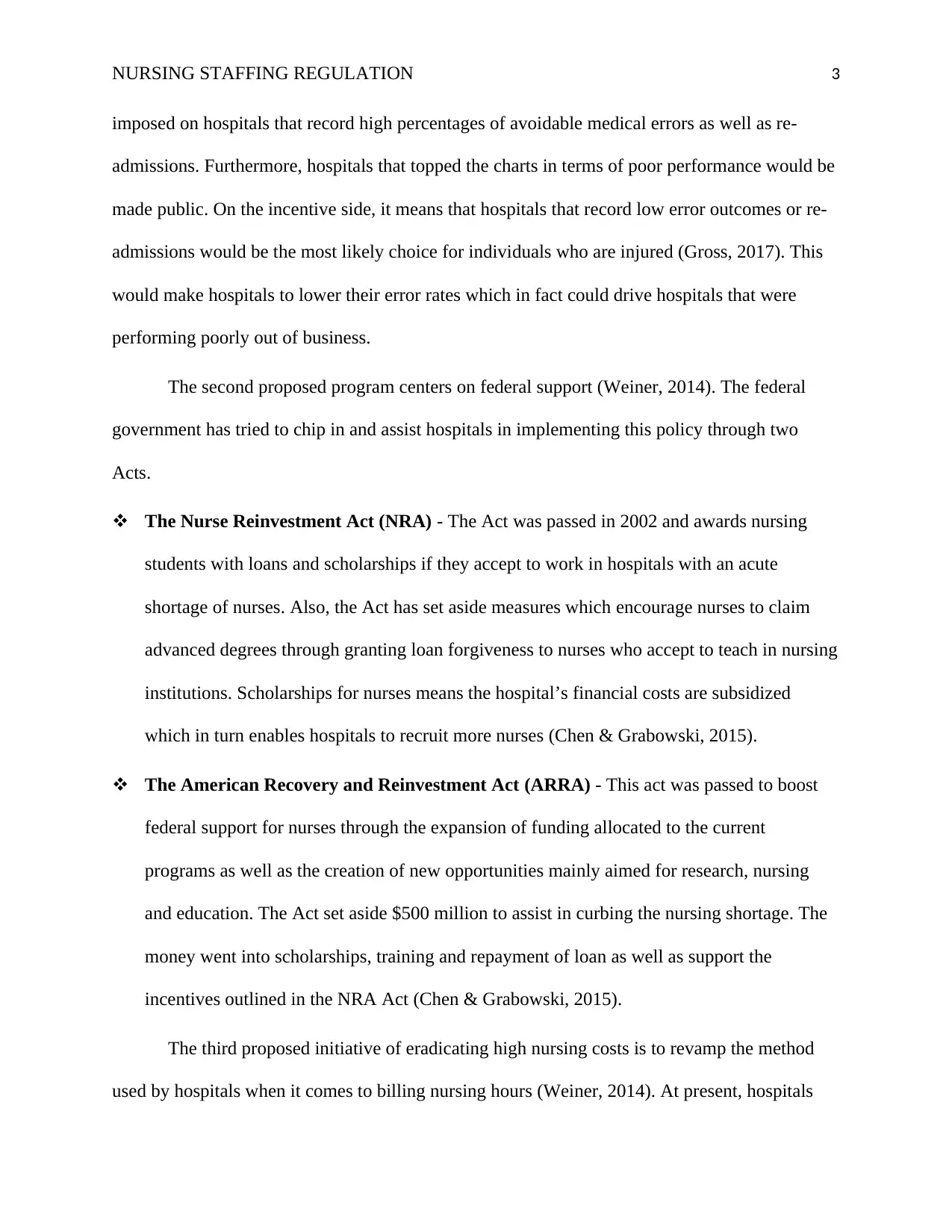
NURSING STAFFING REGULATION 3
imposed on hospitals that record high percentages of avoidable medical errors as well as re-
admissions. Furthermore, hospitals that topped the charts in terms of poor performance would be
made public. On the incentive side, it means that hospitals that record low error outcomes or re-
admissions would be the most likely choice for individuals who are injured (Gross, 2017). This
would make hospitals to lower their error rates which in fact could drive hospitals that were
performing poorly out of business.
The second proposed program centers on federal support (Weiner, 2014). The federal
government has tried to chip in and assist hospitals in implementing this policy through two
Acts.
The Nurse Reinvestment Act (NRA) - The Act was passed in 2002 and awards nursing
students with loans and scholarships if they accept to work in hospitals with an acute
shortage of nurses. Also, the Act has set aside measures which encourage nurses to claim
advanced degrees through granting loan forgiveness to nurses who accept to teach in nursing
institutions. Scholarships for nurses means the hospital’s financial costs are subsidized
which in turn enables hospitals to recruit more nurses (Chen & Grabowski, 2015).
The American Recovery and Reinvestment Act (ARRA) - This act was passed to boost
federal support for nurses through the expansion of funding allocated to the current
programs as well as the creation of new opportunities mainly aimed for research, nursing
and education. The Act set aside $500 million to assist in curbing the nursing shortage. The
money went into scholarships, training and repayment of loan as well as support the
incentives outlined in the NRA Act (Chen & Grabowski, 2015).
The third proposed initiative of eradicating high nursing costs is to revamp the method
used by hospitals when it comes to billing nursing hours (Weiner, 2014). At present, hospitals
imposed on hospitals that record high percentages of avoidable medical errors as well as re-
admissions. Furthermore, hospitals that topped the charts in terms of poor performance would be
made public. On the incentive side, it means that hospitals that record low error outcomes or re-
admissions would be the most likely choice for individuals who are injured (Gross, 2017). This
would make hospitals to lower their error rates which in fact could drive hospitals that were
performing poorly out of business.
The second proposed program centers on federal support (Weiner, 2014). The federal
government has tried to chip in and assist hospitals in implementing this policy through two
Acts.
The Nurse Reinvestment Act (NRA) - The Act was passed in 2002 and awards nursing
students with loans and scholarships if they accept to work in hospitals with an acute
shortage of nurses. Also, the Act has set aside measures which encourage nurses to claim
advanced degrees through granting loan forgiveness to nurses who accept to teach in nursing
institutions. Scholarships for nurses means the hospital’s financial costs are subsidized
which in turn enables hospitals to recruit more nurses (Chen & Grabowski, 2015).
The American Recovery and Reinvestment Act (ARRA) - This act was passed to boost
federal support for nurses through the expansion of funding allocated to the current
programs as well as the creation of new opportunities mainly aimed for research, nursing
and education. The Act set aside $500 million to assist in curbing the nursing shortage. The
money went into scholarships, training and repayment of loan as well as support the
incentives outlined in the NRA Act (Chen & Grabowski, 2015).
The third proposed initiative of eradicating high nursing costs is to revamp the method
used by hospitals when it comes to billing nursing hours (Weiner, 2014). At present, hospitals
⊘ This is a preview!⊘
Do you want full access?
Subscribe today to unlock all pages.

Trusted by 1+ million students worldwide
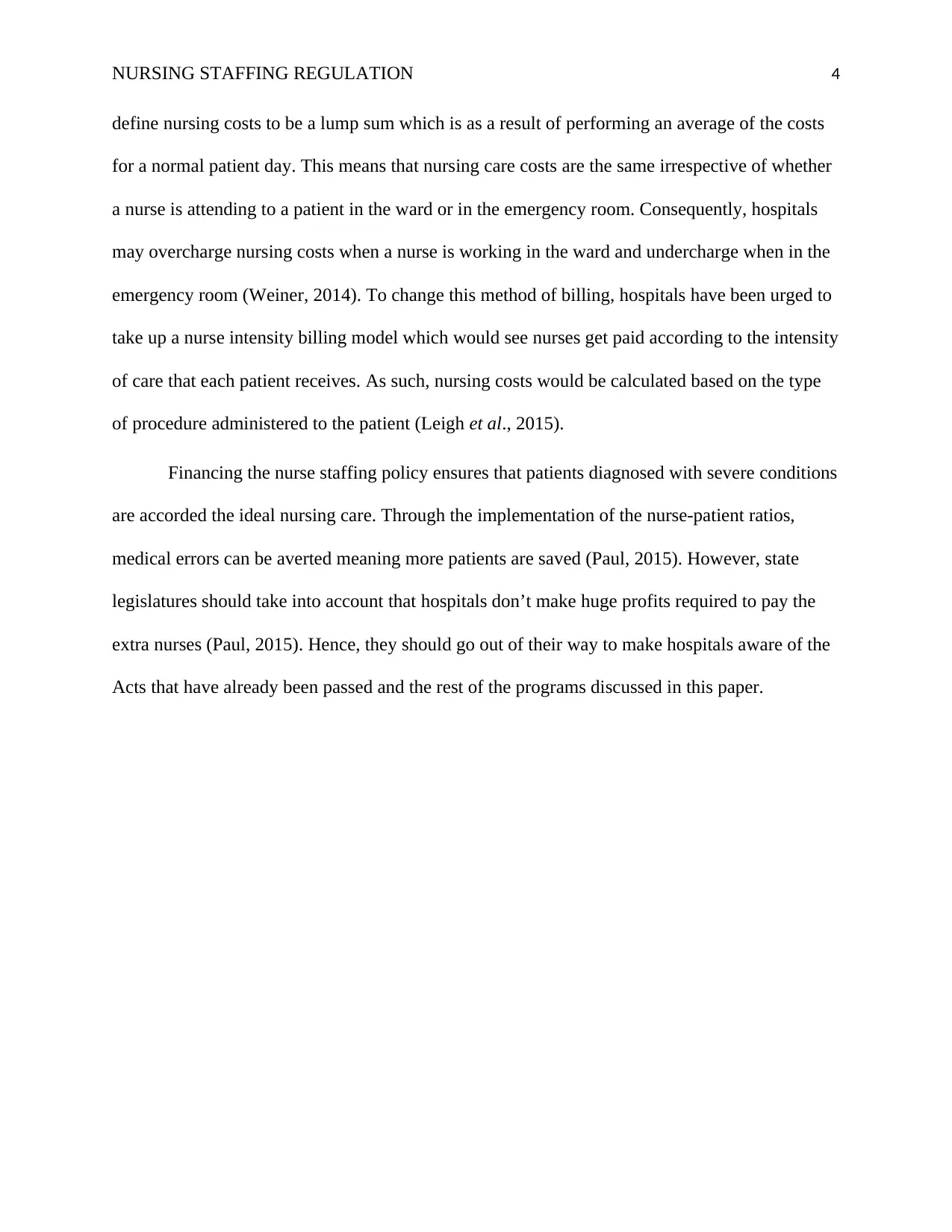
NURSING STAFFING REGULATION 4
define nursing costs to be a lump sum which is as a result of performing an average of the costs
for a normal patient day. This means that nursing care costs are the same irrespective of whether
a nurse is attending to a patient in the ward or in the emergency room. Consequently, hospitals
may overcharge nursing costs when a nurse is working in the ward and undercharge when in the
emergency room (Weiner, 2014). To change this method of billing, hospitals have been urged to
take up a nurse intensity billing model which would see nurses get paid according to the intensity
of care that each patient receives. As such, nursing costs would be calculated based on the type
of procedure administered to the patient (Leigh et al., 2015).
Financing the nurse staffing policy ensures that patients diagnosed with severe conditions
are accorded the ideal nursing care. Through the implementation of the nurse-patient ratios,
medical errors can be averted meaning more patients are saved (Paul, 2015). However, state
legislatures should take into account that hospitals don’t make huge profits required to pay the
extra nurses (Paul, 2015). Hence, they should go out of their way to make hospitals aware of the
Acts that have already been passed and the rest of the programs discussed in this paper.
define nursing costs to be a lump sum which is as a result of performing an average of the costs
for a normal patient day. This means that nursing care costs are the same irrespective of whether
a nurse is attending to a patient in the ward or in the emergency room. Consequently, hospitals
may overcharge nursing costs when a nurse is working in the ward and undercharge when in the
emergency room (Weiner, 2014). To change this method of billing, hospitals have been urged to
take up a nurse intensity billing model which would see nurses get paid according to the intensity
of care that each patient receives. As such, nursing costs would be calculated based on the type
of procedure administered to the patient (Leigh et al., 2015).
Financing the nurse staffing policy ensures that patients diagnosed with severe conditions
are accorded the ideal nursing care. Through the implementation of the nurse-patient ratios,
medical errors can be averted meaning more patients are saved (Paul, 2015). However, state
legislatures should take into account that hospitals don’t make huge profits required to pay the
extra nurses (Paul, 2015). Hence, they should go out of their way to make hospitals aware of the
Acts that have already been passed and the rest of the programs discussed in this paper.
Paraphrase This Document
Need a fresh take? Get an instant paraphrase of this document with our AI Paraphraser
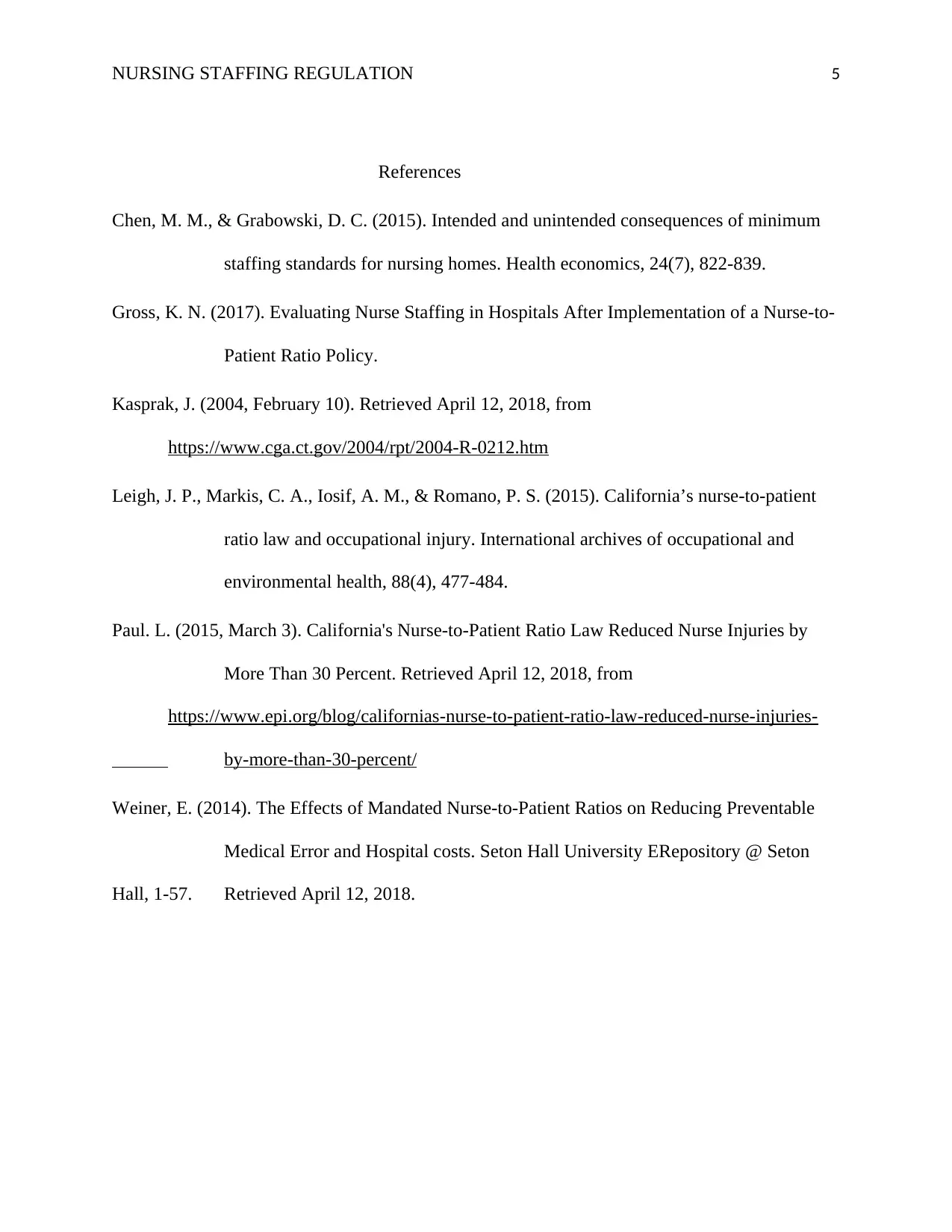
NURSING STAFFING REGULATION 5
References
Chen, M. M., & Grabowski, D. C. (2015). Intended and unintended consequences of minimum
staffing standards for nursing homes. Health economics, 24(7), 822-839.
Gross, K. N. (2017). Evaluating Nurse Staffing in Hospitals After Implementation of a Nurse-to-
Patient Ratio Policy.
Kasprak, J. (2004, February 10). Retrieved April 12, 2018, from
https://www.cga.ct.gov/2004/rpt/2004-R-0212.htm
Leigh, J. P., Markis, C. A., Iosif, A. M., & Romano, P. S. (2015). California’s nurse-to-patient
ratio law and occupational injury. International archives of occupational and
environmental health, 88(4), 477-484.
Paul. L. (2015, March 3). California's Nurse-to-Patient Ratio Law Reduced Nurse Injuries by
More Than 30 Percent. Retrieved April 12, 2018, from
https://www.epi.org/blog/californias-nurse-to-patient-ratio-law-reduced-nurse-injuries-
by-more-than-30-percent/
Weiner, E. (2014). The Effects of Mandated Nurse-to-Patient Ratios on Reducing Preventable
Medical Error and Hospital costs. Seton Hall University ERepository @ Seton
Hall, 1-57. Retrieved April 12, 2018.
References
Chen, M. M., & Grabowski, D. C. (2015). Intended and unintended consequences of minimum
staffing standards for nursing homes. Health economics, 24(7), 822-839.
Gross, K. N. (2017). Evaluating Nurse Staffing in Hospitals After Implementation of a Nurse-to-
Patient Ratio Policy.
Kasprak, J. (2004, February 10). Retrieved April 12, 2018, from
https://www.cga.ct.gov/2004/rpt/2004-R-0212.htm
Leigh, J. P., Markis, C. A., Iosif, A. M., & Romano, P. S. (2015). California’s nurse-to-patient
ratio law and occupational injury. International archives of occupational and
environmental health, 88(4), 477-484.
Paul. L. (2015, March 3). California's Nurse-to-Patient Ratio Law Reduced Nurse Injuries by
More Than 30 Percent. Retrieved April 12, 2018, from
https://www.epi.org/blog/californias-nurse-to-patient-ratio-law-reduced-nurse-injuries-
by-more-than-30-percent/
Weiner, E. (2014). The Effects of Mandated Nurse-to-Patient Ratios on Reducing Preventable
Medical Error and Hospital costs. Seton Hall University ERepository @ Seton
Hall, 1-57. Retrieved April 12, 2018.
1 out of 5
Your All-in-One AI-Powered Toolkit for Academic Success.
+13062052269
info@desklib.com
Available 24*7 on WhatsApp / Email
![[object Object]](/_next/static/media/star-bottom.7253800d.svg)
Unlock your academic potential
Copyright © 2020–2025 A2Z Services. All Rights Reserved. Developed and managed by ZUCOL.
